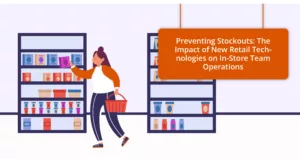The American supermarket has deep roots in retail history, born from a distinctly American innovation: the self-service model pioneered by trailblazers like Piggly Wiggly.
For decades, the supermarket reigned supreme. But today, that once-revolutionary model is under mounting pressure. It’s being squeezed from all sides by sprawling supercenters like Walmart, Target, and Costco, known for their vast selections and unbeatable prices and by a fast-growing network of urban and convenience stores delivering on speed, service, and unique experiences.
The challenge for today’s supermarket? Competing on multiple fronts at once.
Success now depends on embracing its hybrid identity, a powerful asset, but also a complex operational balancing act. In a world where every decision is a trade-off, mastering operational performance tools isn’t just an advantage, it’s a must.
The supermarket's strategic squeeze: A challenge on two fronts
To understand the modern supermarket’s ambivalent position, we have to look back at its origins and the giants it eventually spawned.
From industry disruptor to the squeezed middle
The self-service supermarket was a groundbreaking American invention.
It marked a radical departure from the fragmented world of small specialty shops — the butcher, the grocer, the baker — with a revolutionary one-stop-shop model. Consumers, accustomed to being guided and advised, were initially a bit lost, but the habit quickly took hold, and the supermarket became the symbol of a new era of consumerism.
This model was so successful that it was studied and adopted worldwide.
Visionary entrepreneurs, inspired by pioneers like Bernardo Trujillo (the “pope of modern distribution”), even pushed the concept to its limits, leading to the creation of the first hypermarket worldwide, in France, in the 1960s. This bigger, bolder format made its way back to American soil in the form of today’s supercenters.
Faced with this new colossus, the classic supermarket was forced to redefine itself. It couldn’t out Walmart, so it had to carve out its own defensible territory: the sweet spot between mass-market efficiency and local-market appeal.
Defining the supermarket's business strategy
To stay competitive against both hypermarkets, specialty grocers and urban stores, the supermarket is staking its claim in the “in-between.”
Let’s break that down by looking at the extremes on either side:
Hypermarkets operate with a wide geographic reach and rely on three key strengths:
- Low pricing: Their price index is typically 3+ points lower than traditional supermarkets, especially when compared to the most competitive chains.
- Aggressive promotions: A larger share of their sales comes from promotional offers.
- Deep assortments: Their wide range of products is unmatched.
The supermarket, with its smaller surface area and catchment area, cannot support such a model. Its offer is smaller, more local and focused on food. Non-food products are deliberately kept to a minimum, as they cannot compete with the depth of range offered by hypermarkets or specialist chains. These are mainly service products such as light bulbs, batteries, etc.
Urban and convenience stores, meanwhile, don’t directly threaten the supermarket’s core offer. But they’ve changed consumer expectations. Shoppers now demand higher service quality, better experiences, and more attention to detail. That’s where the supermarket’s “local aspiration” comes into play. To stay relevant, it must adopt the codes and best practices of proximity retail while offering added services like curbside pickup, gas stations, and even car rentals.
The path to victory: Mastering operations to win from the middle
So how does a supermarket thrive while being pulled in both directions?
Not by picking a side, but by excelling at execution. Here’s how:
Foundational strategy: From guesswork to data-driven clarity
The biggest challenge of the “in-between” model is managing a wide mix of tasks, from shelf replenishment and checkout operations to customer service, cleaning, and click-and-collect. Without the right tools, managers rely on guesswork.
That’s where a solution like TimeSkipper comes in. It turns rough estimates into precise calculations, using each store’s own data – like delivery volumes and customer traffic – to determine real workload, hour by hour, department by department.
Suddenly, the manager isn’t operating blindly. They have a clear plan: who needs to be where, doing what, and when.
Advanced execution: Proactive management of staff and service
Once the workload is clear, the main challenge is ensuring excellent customer service while maintaining impeccable store conditions. TimeSkipper helps solve this dilemma by allowing managers to “ring-fence” dedicated time for customer service. By scheduling production tasks (like stocking and cleaning) during off-peak hours, it frees up teams to be fully dedicated to customers during peak traffic, ensuring a store that is “clean, stocked, and accurately priced.”
Furthermore, to remain attractive, a supermarket cannot afford to be constantly reacting to unforeseen events. TimeSkipper enables a shift from reactive to proactive leadership. The manager gets clear dashboards showing the alignment between scheduled hours and the actual workload. They can identify bottlenecks, anticipate needs, and adjust schedules based on facts, not just intuition, which helps optimize every labor hour.
In the end, the strategy for how to compete with supercenters, specialty grocers and urban stores is about flawless execution.
By using data to master its unique operational challenges, the supermarket can turn its “in-between” position from a vulnerability into its key strategic asset. A tool like TimeSkipper provides the rigor of a large corporation while preserving the agility needed in a local retail environment, giving supermarkets the means to not just survive the squeeze, but to win from the middle.





